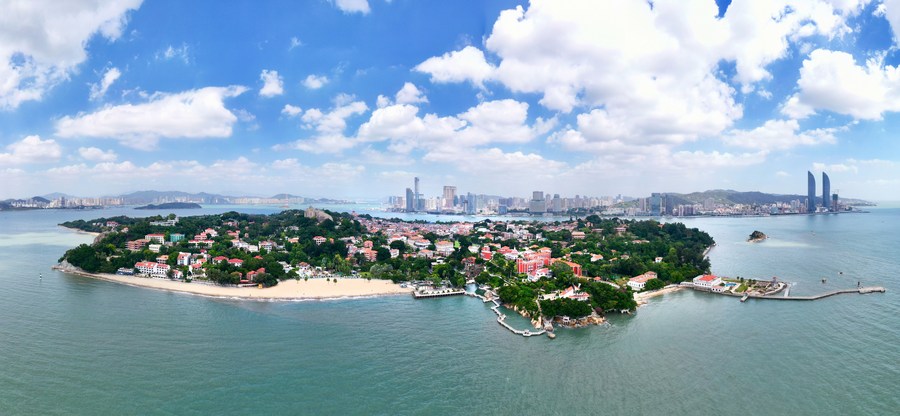
Aerial photo taken on Oct. 6, 2021 shows the view of Gulangyu Island in Xiamen, southeast China's Fujian Province. (Xinhua/Jiang Kehong)
One day in 1986, Gong Jie, the museum curator of the municipal museum of Xiamen, extended a bold invitation. While he knew all too well that the destination he had in mind was far from welcoming, his decision proved to be one of his proudest moments.
Gong's potential guest was Xi Jinping, then deputy mayor of Xiamen. Xi was on Gulangyu, a small island known as a "museum of global architecture" boasting over 1,000 historical buildings in various styles combining Chinese and Western elements, to deliver a speech.
After the address, as Xi walked out of the hall, Gong stopped him and said: "Deputy mayor, please come and visit Bagua Mansion." Gong was unsure how Xi would take the abrupt invitation, but he accepted straight away.
Constructed in 1907, the Bagua Mansion, a blend of architectural styles, is a landmark historical building on the island. Atop a hillside overlooking Xiamen city center, the building has a signature red dome that decorates the city's skyline like a ruby gem.
Over the years, the mansion had been used for many functions. By the 1960s, it housed a factory and began to fall into disrepair.
In 1983, the municipal government decided to renovate the dilapidated mansion and make it into a museum, which is when Gong came on board, as the renovation coordinator. Despite the municipal government channeling funds to the project, there was a lot of work to do, and money was tight, which is why Gong took a punt at inviting Xi to view the mansion.
At the time, the building was divided into several small compartments, and around a dozen households lived in the basement. The wooden floor, warped by weather and time, creaked whenever anyone stepped on it, and the roof was rotten and moldy -- hardly a welcoming place to receive a guest.
Gong gave Xi a "tour" of the mansion. Xi did not even make it to the first floor before turning to Gong and saying: "How much more do you need?"
Gong requested 300,000 yuan (about 45,000 U.S. dollars). This was no small sum for the city at that time, as the recent creation of a special economic zone in Xiamen had resulted in a boom of development projects, all thirsty for funding.
"Come get it tomorrow," Xi answered without hesitation.
Gong remembered how excited he was. "I will never forget his decisiveness," he said, adding that the injection of cash came at the most stressful and difficult time, and the fate of the century-old building was completely changed.
After the refurbishment project was complete, Bagua Mansion was born again, this time as Xiamen's municipal museum. Together with 52 other notable examples of architecture, the mansion was included as a core element of Gulangyu's cultural heritage and was lauded by experts from the United Nations in the process of the island's entering the UNESCO World Heritage List.
While working in Xiamen, Xi led the formulation of a plan for the city's economic and social development in the coming 15 years through 2000. In the document's attachment, a special report elucidated the social and cultural value of Gulangyu, noting that the island is "a treasure of the nation" and stressing a unified planning for its construction and preservation commensurate with this status.
From preserving a building to valuing an island, preserving culture and heritage remains cherished pursuits of Xi's governance philosophy.
Noting that both historical and cultural heritage are irreplaceable, precious resources, Xi said their preservation is a top priority.
"Our ancestors left us our historical and cultural heritage, and we must pass it down to future generations intact," Xi stressed.

